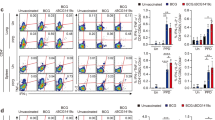Abstract
Tuberculosis remains the worldwide infectious disease. To identify the therapeutic potential of M. vaccae in treating tuberculosis, M. vaccae was injected into Mycobacterium tuberculosis (M. tuberculosis) infected mice. The optimal dose of M. vaccae (22.5 µg/mouse) treated mice showed lower pathological change index, spleen weight index, lung weight index and vital M. tuberculosis count than those of the untreated group. Treatment with M. vaccae enhanced the percentages of CD3+ and CD4+ T cells, IFN-γ+CD4+ T cells, innate immune cells including NK cells, NK1.1+ T cells and γδ T cells, and reduced the percentage of IL-4+CD4+ T cells. Therefore, M. vaccae could protect the mice from M. tuberculosis infection and improved mouse innate and adaptive cell-mediated immunity, suggesting that M. vaccae is a potential immunotherapeutic agent in pulmonary tuberculosis.
This is a preview of subscription content, access via your institution
Access options
Subscribe to this journal
Receive 12 digital issues and online access to articles
$119.00 per year
only $9.92 per issue
Buy this article
- Purchase on Springer Link
- Instant access to full article PDF
Prices may be subject to local taxes which are calculated during checkout
Similar content being viewed by others

Author information
Authors and Affiliations
Corresponding authors
Rights and permissions
About this article
Cite this article
Xu, L., Wang, Y., Zheng, X. et al. Immunotherapeutical Potential of Mycobacterium Vaccae on M. Tuberculosis Infection in Mice. Cell Mol Immunol 6, 67–72 (2009). https://doi.org/10.1038/cmi.2009.9
Received:
Accepted:
Issue Date:
DOI: https://doi.org/10.1038/cmi.2009.9
Keywords
This article is cited by
-
Effects of Mycobacterium vaccae vaccine in a mouse model of tuberculosis: protective action and differentially expressed genes
Military Medical Research (2020)


